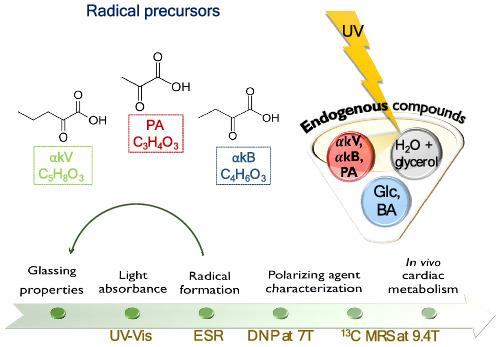当前位置:
X-MOL 学术
›
NMR Biomed.
›
论文详情
Our official English website, www.x-mol.net, welcomes your
feedback! (Note: you will need to create a separate account there.)
Radical-free hyperpolarized MRI using endogenously occurring pyruvate analogues and UV-induced nonpersistent radicals
NMR in Biomedicine ( IF 2.7 ) Pub Date : 2021-07-10 , DOI: 10.1002/nbm.4584 Claudia C Zanella 1 , Andrea Capozzi 1 , Hikari A I Yoshihara 1 , Alice Radaelli 1 , Adèle L C Mackowiak 2 , Lionel P Arn 2 , Rolf Gruetter 1 , Jessica A M Bastiaansen 2
NMR in Biomedicine ( IF 2.7 ) Pub Date : 2021-07-10 , DOI: 10.1002/nbm.4584 Claudia C Zanella 1 , Andrea Capozzi 1 , Hikari A I Yoshihara 1 , Alice Radaelli 1 , Adèle L C Mackowiak 2 , Lionel P Arn 2 , Rolf Gruetter 1 , Jessica A M Bastiaansen 2
Affiliation

|
It was recently demonstrated that nonpersistent radicals can be generated in frozen solutions of metabolites such as pyruvate by irradiation with UV light, enabling radical-free dissolution dynamic nuclear polarization. Although pyruvate is endogenous, the presence of pyruvate may interfere with metabolic processes or the detection of pyruvate as a metabolic product, making it potentially unsuitable as a polarizing agent. Therefore, the aim of the current study was to characterize solutions containing endogenously occurring alternatives to pyruvate as UV-induced nonpersistent radical precursors for in vivo hyperpolarized MRI. The metabolites alpha-ketovalerate (αkV) and alpha-ketobutyrate (αkB) are analogues of pyruvate and were chosen as potential radical precursors. Sample formulations containing αkV and αkB were studied with UV–visible spectroscopy, irradiated with UV light, and their nonpersistent radical yields were quantified with electron spin resonance and compared with pyruvate. The addition of 13C-labeled substrates to the sample matrix altered the radical yield of the precursors. Using αkB increased the 13C-labeled glucose liquid-state polarization to 16.3% ± 1.3% compared with 13.3% ± 1.5% obtained with pyruvate, and 8.9% ± 2.1% with αkV. For [1–13C]butyric acid, polarization levels of 12.1% ± 1.1% for αkV, 12.9% ± 1.7% for αkB, 1.5% ± 0.2% for OX063 and 18.7% ± 0.7% for Finland trityl, were achieved. Hyperpolarized [1–13C]butyrate metabolism in the heart revealed label incorporation into [1–13C]acetylcarnitine, [1–13C]acetoacetate, [1–13C]butyrylcarnitine, [5-13C]glutamate and [5-13C]citrate. This study demonstrates the potential of αkV and αkB as endogenous polarizing agents for in vivo radical-free hyperpolarized MRI. UV-induced, nonpersistent radicals generated in endogenous metabolites enable high polarization without requiring radical filtration, thus simplifying the quality-control tests in clinical applications.
中文翻译:

使用内源性丙酮酸类似物和紫外线诱导的非持久性自由基进行无自由基超极化 MRI
最近的研究表明,通过紫外线照射,可以在丙酮酸等代谢物的冷冻溶液中产生非持久性自由基,从而实现无自由基溶解动态核极化。尽管丙酮酸是内源性的,但丙酮酸的存在可能会干扰代谢过程或丙酮酸作为代谢产物的检测,使其可能不适合作为偏振剂。因此,当前研究的目的是表征含有内源性丙酮酸替代品的溶液,作为体内超极化 MRI 的紫外线诱导的非持久性自由基前体。代谢物 α-酮戊酸 ( α kV) 和 α-酮丁酸 ( α kB) 是丙酮酸的类似物,被选为潜在的自由基前体。使用紫外-可见光谱研究了含有α kV 和α kB 的样品配方,并用紫外光照射,并使用电子自旋共振定量了它们的非持久性自由基产量,并与丙酮酸盐进行了比较。向样品基质中添加13 C 标记底物改变了前体的自由基产率。使用α kB 将13 C 标记的葡萄糖液态极化增加至 16.3% ± 1.3%,而使用丙酮酸获得的 13.3% ± 1.5% 和使用α kV 获得的 8.9% ± 2.1% 相比。对于[1– 13 C]丁酸, α kV 的极化水平为 12.1% ± 1.1%, α kB 的极化水平为 12.9% ± 1.7%,OX063 的极化水平为 1.5% ± 0.2%,芬兰三苯甲基的极化水平为 18.7% ± 0.7% 。 心脏中超极化的 [1– 13 C]丁酸盐代谢显示标记掺入到 [1– 13 C]乙酰肉碱、[1– 13 C]乙酰乙酸、[1– 13 C]丁酰肉碱、[5- 13 C]谷氨酸和 [5] - 13 C]柠檬酸盐。这项研究证明了α kV 和α kB 作为体内无自由基超极化 MRI 内源性极化剂的潜力。紫外线诱导的内源代谢物中产生的非持久性自由基可实现高极化,无需自由基过滤,从而简化了临床应用中的质量控制测试。
更新日期:2021-07-10
中文翻译:

使用内源性丙酮酸类似物和紫外线诱导的非持久性自由基进行无自由基超极化 MRI
最近的研究表明,通过紫外线照射,可以在丙酮酸等代谢物的冷冻溶液中产生非持久性自由基,从而实现无自由基溶解动态核极化。尽管丙酮酸是内源性的,但丙酮酸的存在可能会干扰代谢过程或丙酮酸作为代谢产物的检测,使其可能不适合作为偏振剂。因此,当前研究的目的是表征含有内源性丙酮酸替代品的溶液,作为体内超极化 MRI 的紫外线诱导的非持久性自由基前体。代谢物 α-酮戊酸 ( α kV) 和 α-酮丁酸 ( α kB) 是丙酮酸的类似物,被选为潜在的自由基前体。使用紫外-可见光谱研究了含有α kV 和α kB 的样品配方,并用紫外光照射,并使用电子自旋共振定量了它们的非持久性自由基产量,并与丙酮酸盐进行了比较。向样品基质中添加13 C 标记底物改变了前体的自由基产率。使用α kB 将13 C 标记的葡萄糖液态极化增加至 16.3% ± 1.3%,而使用丙酮酸获得的 13.3% ± 1.5% 和使用α kV 获得的 8.9% ± 2.1% 相比。对于[1– 13 C]丁酸, α kV 的极化水平为 12.1% ± 1.1%, α kB 的极化水平为 12.9% ± 1.7%,OX063 的极化水平为 1.5% ± 0.2%,芬兰三苯甲基的极化水平为 18.7% ± 0.7% 。 心脏中超极化的 [1– 13 C]丁酸盐代谢显示标记掺入到 [1– 13 C]乙酰肉碱、[1– 13 C]乙酰乙酸、[1– 13 C]丁酰肉碱、[5- 13 C]谷氨酸和 [5] - 13 C]柠檬酸盐。这项研究证明了α kV 和α kB 作为体内无自由基超极化 MRI 内源性极化剂的潜力。紫外线诱导的内源代谢物中产生的非持久性自由基可实现高极化,无需自由基过滤,从而简化了临床应用中的质量控制测试。











































 京公网安备 11010802027423号
京公网安备 11010802027423号